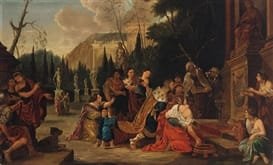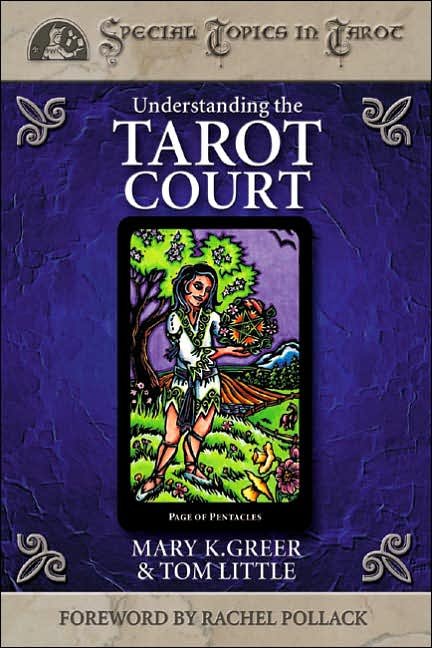After I wrote the entire Understanding The Court Cards Series a few weeks ago, I suddenly remembered that I had read this amazing book a few years ago, and it had inspired me a lot. So I decided to write a review of this amazing book for you guys as well. 🙂
If at all you find yourself confused about the court cards and if you really want to explore the court cards in depth, then Understanding the Tarot Court by Mary K. Greer & Tom Little is just the book you want to buy.
Filled with a lot of practical, hands-on exercises designed precisely to help you connect with and get to know the court cards, this book was written for beginners and ‘advanced’ Tarot-ists as well.
So, lets have a look at what the book is all about.
Understanding The Tarot Court by Mary K. Greer & Tom Little
The book is divided into 9 Chapters and has 4 Appendices. Each chapter focuses on a different aspect of the Court Cards, and uses a combination of information and practical exercises to help you get to know the people cards in your Tarot deck.
Oh, and lest I forget to mention, the book has a very interesting Foreword by none other than my favorite, Rachel Pollack. 🙂
Introduction
This is a short intro to the book and gives you some really handy tips for how to use the book.
Chapter One: The Many Faces of the Tarot Court

In this chapter, we are introduced to the Court Cards, and learn about their corresponding element associations. We are also invited to a Court Card Beach Party (a very brilliant exercise) where we see how these courts act around each other and interact with one another. A handy chart outlines the different ways Court Cards are named in different decks. We then look deeper into Significators and how to use Court Cards as Significators with a very interesting exercise.
Chapter Two: The Court Card Family
In this chapter we get to know the Courts from the perspective of a family model where the King is the Father, the Queen is the Mother, the Knight is the Son and the Page is the Daughter. A couple of interesting exercises help you really internalize the learning.
Chapter Three: The Court in Society
Now, here is where we delve into the history of Court Cards and learn how they evolved. And from that learning, we move forward into the area of interpretation, where with the use of some really cool exercises we derive stuff like the roles and professions of a court card, and career choices for a court card. We also look deeper into these cards using a Storytelling exercise.
Chapter Four: The Court Within
This chapter links the court cards with personalities using connectors such as Astrology and the Myers-Briggs Personality Type Indicator analysis. We also look at the reversed interpretation aspects of the Court Cards.
(You can also refer to the Tarot Reversals book for more in-depth analysis of reversed cards.)
Chapter Five: Court Card Relationships
 This chapter looks deeper into the relationship aspect of the courts. We get to know how to relate court cards with friends and family members. We talk a bit about projection (and learn about our own projections with a very deep exercise). We also talk about looking at court cards as guides, teachers and mentors, and do an exercise to connect with your inner teacher card. Court card dialogs get these courts talking with each other, and the relationship spread puts it all together. After that, we look at the interaction between the couples in the Tarot deck, and look at how one can analyze group dynamics with the court cards. We also see how we can interpret the appearance of multiple court cards in readings.
This chapter looks deeper into the relationship aspect of the courts. We get to know how to relate court cards with friends and family members. We talk a bit about projection (and learn about our own projections with a very deep exercise). We also talk about looking at court cards as guides, teachers and mentors, and do an exercise to connect with your inner teacher card. Court card dialogs get these courts talking with each other, and the relationship spread puts it all together. After that, we look at the interaction between the couples in the Tarot deck, and look at how one can analyze group dynamics with the court cards. We also see how we can interpret the appearance of multiple court cards in readings.
Chapter Six: The Court and The Cosmos
This chapter looks at the court cards in terms of broader traditions such as Neoplatonism, Neo Pagan Cosmology, Kabala, Golden Dawn, Elemental Dignities, Astrology and Numerology.
Chapter Seven: Bringing It All Together
As the title suggests, this chapter helps you puts all the above mentioned stuff together in one place and helps you get to the reading part with sample readings.
Chapter Eight: Build Your Own Court
And if, after reading all of this stuff, you are inspired to create / build your own framework of Court Cards, then this chapter provides you with the guidance, methodology and tools to help you do just that.
Chapter Nine: Court Card Interpretations
But of course, this section’s gotta be there, right? After all this learning, we can also check out the different interpretations that can also occur for the court cards. For each card, you will find information about: 
- Typical roles, masks, sub-personalities
- Personality styles and values
- Stresses, problems, weaknesses
- Sample occupations
- Events, situations, activities
- Advice
- Traditional meanings
- Traditional reversed meanings
The Appendices
These contain mostly cheat-sheets that also help put stuff together in a chart form. These include:
- A court card comparison chart
- Myers-Briggs court card comparison chart
- Golden Dawn court card correspondences
- A list of important terms and their meanings
All in all, this is a really great book to have, learn and keep learning from. As I have always said, court cards are people. And there will never be an end to all the interesting insights and learning that can be gained from the study of people.
Buy The Book
In case you can’t see the ad above, click here to order the book from Amazon.
Your Turn…
So, what do you think? Will you buy this book? Or do you already have this book? If so, what did you think of it? Did it enrich or enhance your understanding of the court cards? Do let me know in the comments section below.










